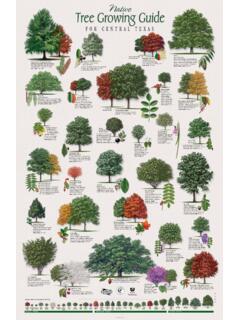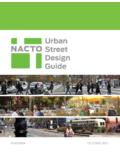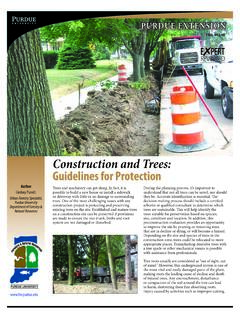Transcription of Land Use / Land Cover Analysis- Third Cycle
1 NATURAL RESOURCE CENSUS Land Use / Land Cover Analysis- Third Cycle Technical Document on Land Use / Land Cover Database for Dissemination through Bhuvan Land Use & Cover Monitoring Division LRUMG Remote Sensing Applications Area NATIONAL REMOTE SENSING CENTRE (DEPT. OF SPACE, GOVT. OF INDIA) HYDERABAD June, 2019 NRSC/ISRO National Remote Sensing Centre Document Control Sheet 01. Security Classification Unrestricted 02. Distribution General 03. Document Version (a) Issue no. 01 (b)Revision &Date -- 04. Document Type Technical Report Ver. 1 05. Document Control Number 06. Title Natural Resource Census Land Use / Land Cover Database for Dissemination through Bhuvan 07. Particulars of Collation Pages - 11 Figures Tables - 2 References - 8 08. Author(s) Dr. Manoj Raj Saxena, Shri.
2 Rajiv Kumar, Shri. J Chandra Mohan, Dr. Divya Vijayan, Shri. Mohit Modi, Shri. Dhiroj Kumar Behera, Dr. Kuntal Ganguly, Ms Ravali Bhardwaj, Ms. V Satya Sahithi, Ms. P. Harshitha, Ms. Isharat Begum 09. Affiliation of Authors LU & CM Division, LRUM Group, Remote Sensing Applications Area, NRSC 10. Scrutiny Mechanism Compiled By: Dr. G Ravi Shankar, Head, LU & CMD Reviewed By: Dr. T Ravisankar, GD,LRUM Approved / Controlled By: Dr. PVN Rao, DD RSA A 11. Originating Unit LU&CMD,LRUMG, RSA A 12. Sponsor(s)/Name & Address NNRMS, ISRO, Bengaluru 13. Date of Initiation June, 2019 14. Date of Publication June, 2019 15. Abstract(with Keywords) The geo-spatial database on Land Use/ Land Cover ( Third Cycle ) on 1:50,000 scale is prepared using three season Resourcesat 2 ortho rectified LISS III data of 2015 16.
3 Entire database are prepared by NRSC, ISRO under Natural Resources Census (NRC) Project of National Natural Resources Repository (NRR) Programme with the participation of 29 State Remote Sensing Centers spread over entire country. Interpretation of satellite imagery is done using visual interpretation technique and individual classes were interpreted using their visual characteristics. The LULC database is prepared with 54 class LULC Classification Schema and are harmonized to 24 class for disseminating through Bhuvan, ISRO Geoportal by emphasing more on Land Cover . Output is in GIS vector file format, prepared using LCC projection and WGS84 as datum. This will serve the requirements of academia, researchers, planners etc. NRSC/ISRO NATURAL RESOURCE CENSUS LAND USE LAND Cover DATABASE FOR DISSEMINATION THROUGH BHUVAN INTRODUCTION Earth observations from space platforms play a crucial role in generation and dissemination of information on LULC pattern in a timely and reliable manner providing vital inputs required for optimal land use planning.
4 The evolution of Indian remote sensing program over the past two decades, providing a variety of remote sensing based solutions for national development, is an apt and timely national initiative. Some of the important projects of ISRO/DOS under the theme of LULC are given in the Table 1. Table 1: Major Land Use Land Cover Mapping Projects carried out by ISRO / DOS PROJECT NAME YEAR 1 Nationwide Wasteland Mapping 1985, 1986 1999, 2003, 2005-06, 2008-09, 2015-16 2 Land Use Land Cover Mapping for Planning based on Agro Climatic Zone 1989 1990 3 Nationwide Wetland Mapping 1995 4 urban Sprawl of Million Plus Cities 1988 1990 5 Land Use Land Cover Database for Zoning Atlas for siting of Industries 1999 6 urban Information Systems (BMR; NCR; MMDA; AUDA, HUDA,NCRPB etc. From 1990 onwards at different times 7 Land Use Land Cover Mapping using AWiFS data 2004 onwards at one year of interval 8 Integrated Mission for Sustainable Development 1992 1998 9 Integrated Resource Information for Desert Areas 2002 10 Land Use/Land Cover Mapping on 1 : 50,000 scale 2005-06, 2011-12 A project on National Land Use/ Land Cover Mapping on 1:50,000 scale (Second Cycle ) using multi temporal Resourcesat 2 terrain corrected Linear Imaging Self Scanning Sensor (LISS) III data was taken up by DOS, under Natural Resources Census (NRC) Project of National Natural Resources Repository (NRR) Program.)
5 The project has been accomplished with the active participation of various state, central, universities and others partner institutes. The land use/land Cover classification scheme of 1:50,000 scale consists of Level I: 8 classes, Level II: 31 classes and Level III: 54 classes (NRSC, 2012). This classification was finalized after elaborate discussions within the DOS and various Central/State government departments/institutions. The project had been completed and atlas (NRSC, 2011) was released for the use of various departments central, state and others. LULC data is regrouped for web users with an emphasis on land Cover classes as given in Table 2. This has been undertaken keeping in view of volume of data, faster access to database and visualization. 2 NRSC/ISRO Table 2: Grouping of LULC classes of 3rd Cycle Sl.
6 Description 1 Description 2 Classes from NRC LULC50K Mapping Project 1 Builtup urban Built up Compact (Continuous), Built up Sparse (Discontinuous), Built up Vegetated / Open area, Industrial area, Ash / Cooling Pond / effluent and other waste Rural Rural Mining Mining Active, Mining Abandoned, Quarry 2 Agriculture Crop land Kharif, Rabi, Zaid, Cropped in 2 seasons, Cropped in more than 2 seasons Plantation Agriculture Plantation Fallow Fallow land Current Shifting cultivation Shifting cultivation Current 3 Forest Evergreen / Semi evergreen Dense / Closed and Open category of Evergreen / Semi evergreen Deciduous Dense / Closed and Open category of Deciduous and tree Clad Area Forest Plantation Forest Plantation Scrub Forest Scrub Forest, Shifting Cultivation Abandoned Swamp / Mangroves Dense / Closed & Open Mangrove 4 Grass/ Grazing Grass/ Grazing Grassland.
7 Alpine / Sub Alpine, Temperate / Sub Tropical, Tropical / Desertic 5 Barren/unculturable/Wastela Salt Affected Land Salt Affected Land Gullied / Ravinous Land Gullied, Ravinous Scrub land Dense / Closed and Open category of scrub land Sandy area Desertic, Coastal, Riverine sandy area Barren rocky Barren rocky Rann Rann 6 Wetlands / Water Bodies Inland Wetland Wetland Inland Natural (Ox bow lake, cut off meander, waterlogged etc.), Inland Manmade (Water logged, saltpans etc.) Coastal Wetland Wetland Lagoon, creeks, mudflats, Saltpan etc. River / Stream / canals Perennial & Non Perennial River, Canal / Drain Water bodies Aquaculture, Permanent & seasonal Lake/Ponds, Reservoir/Tanks 7 Snow Snow NRSC/ISRO 4 DESCRIPTION OF LAND USE AND LAND Cover CLASSES LULC classification scheme and brief description of classes are as given hereunder: Land Cover is defined as observed physical features on the Earth s Surface.
8 When an economic function is added to it, it becomes Land Use. (FAO, 2005). BUILT UP LAND It is an area of human habitation developed due to non agricultural use and that has a Cover of buildings, transport and communication, utilities in association with water, vegetation and vacant lands. Web LULC map consists of 3 classes under built up viz., urban , rural and mining. urban : urban areas are non linear built up areas covered by impervious structures adjacent to or connected by streets. This Cover is related to centers of population. This class usually occurs in combination with, vegetated areas that are connected to buildings that show a regular pattern, such as vegetated areas, gardens etc. and industrial and/or other areas. (FAO, 2005).It includes residential areas, mixed built up, recreational places, public / semi public utilities, communications, public utilizes/facility, commercial areas, reclaimed areas, vegetated areas, transportation, industrial areas and their dumps, and ash/cooling ponds.
9 Rural: These are the lands used for human settlement of size comparatively less than the urban settlements of which the majority of population is involved in the primary activity of agriculture. These are the built up areas, smaller in size, mainly associated with agriculture and allied sectors and non commercial activities. They can be seen in clusters non contiguous or scattered. Mining: Mining areas encompass area under surface mining operations. The recognizable impacts of these activities on the landscape are unmistakable giant pit mines covering vast areas. The presence of water bodies does not necessarily imply inactive or unused extractive areas; ponds or lakes are often an integral part of an extractive operation. (USGS, 1999) It includes surface rocks and stone quarries, sand and gravel pits, brick kilns, etc.
10 These are areas of stockpile of storage dump of industrial raw material or slag/effluents or waste material or quarried/mixed debris from earth's surface. AGRICULTURAL LAND These are the lands primarily used for farming and for production of food, fiber, and other commercial and horticultural crops. It consists of: Cropland: These are the areas with standing crop as on the date of Satellite overpass. Cropped areas appear in bright red to red in color with varying shape and size in a contiguous to non contiguous pattern. They are widely distributed indifferent terrains; prominently appear in the irrigated areas irrespective of the source of irrigation. It includes kharif, rabi and zaid crop lands along with areas under double or triple NRSC/ISRO 5 Plantations: These are the areas under agricultural tree crops planted adopting agricultural management techniques.








